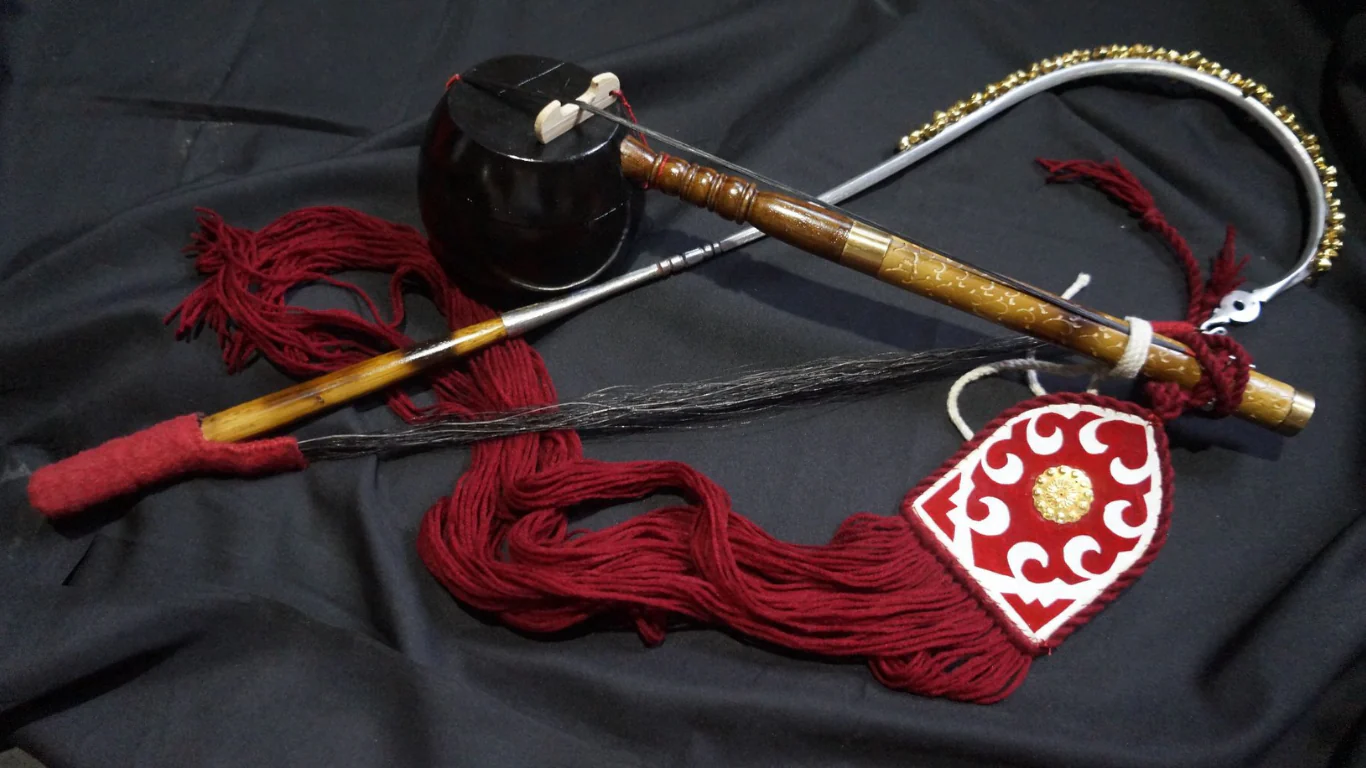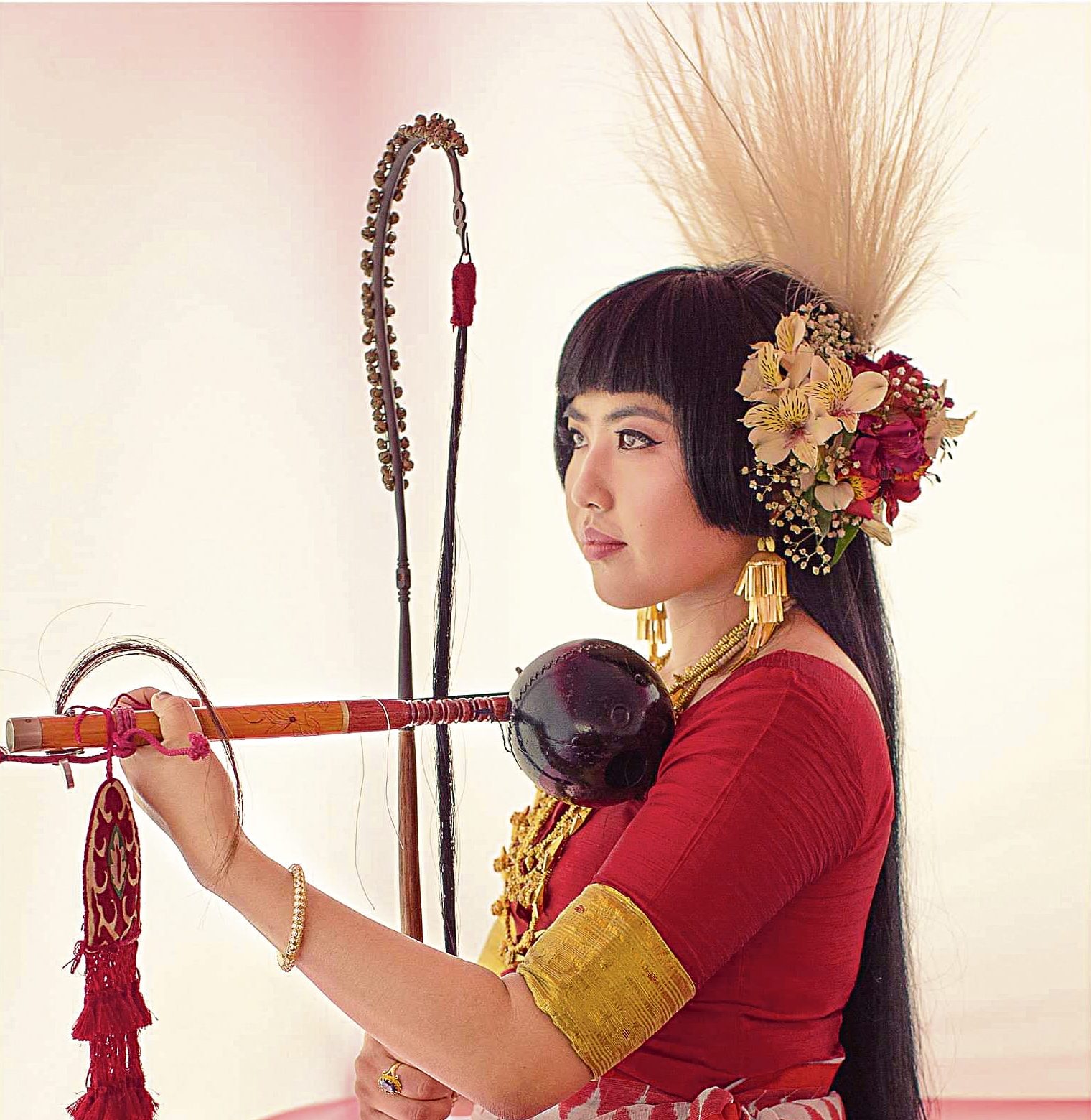Pena
Bowed Instruments
Asia
Between 1001 and 1900 AD
Video
The Pena is a traditional musical instrument that holds a significant place in the cultural tapestry of Manipur, India. As a mono-string instrument, it is categorized within the lute family and is deeply intertwined with the folk traditions of the Meitei people.
It is a unique string instrument that consists of two main components: the body and the bow. The body, known as penamasa or dhorr, resembles that of a violin but has distinct characteristics that set it apart. The bow, referred to as pena cheijing or chorr, is more akin to an archery bow than a traditional violin bow. This instrument typically features a single string made from horsehair or other materials, which produces a rich and resonant sound when played. The Pena is played by drawing the bow across the string while simultaneously pressing on it to create different pitches. This technique allows for expressive melodies that are central to the folk music traditions of Manipur. The Pena is particularly associated with the Lai Haraoba festival, a significant cultural event that celebrates the creation myths and ancestral deities of the Meitei community.
History
The origins of the Pena can be traced back to ancient times in Manipur, specifically among the Meitei people. It is believed to be one of the oldest traditional instruments in this region, with historical references indicating its use in royal gatherings and significant cultural events. The instrument’s name may derive from various linguistic roots, including Sanskrit and Bengali terms related to stringed instruments. The Pena has been an integral part of Manipuri culture for centuries, often linked to rituals and celebrations. It was traditionally played by skilled musicians who were not only entertainers but also considered healers within their communities. The act of playing the Pena was thought to resonate with healing vibrations that could alleviate ailments. In terms of geographical origin, the Pena is primarily associated with Manipur in Northeast India but has connections to broader musical traditions across Asia. Its design and playing techniques share similarities with various Asian string instruments, indicating a rich cultural exchange over centuries. The 20th century saw a decline in the number of active Pena players due to modernization and changing musical preferences; however, recent efforts have been made to revive interest in this traditional art form.
How It Works
The working mechanism of the Pena is relatively straightforward yet fascinating. The instrument consists of a hollow body made from bamboo or wood, which serves as a resonator. This body is typically around 10 inches long and 1 to 1.25 inches in girth. A coconut shell cut in half forms part of the resonating chamber, enhancing the sound quality produced by the instrument. To produce sound, a single string—traditionally made from horsehair—is stretched over this body. The tension of this string can be adjusted using a bamboo peg known as kaan, allowing musicians to tune their instruments according to their needs. The bow used for playing consists of wood with a curved flourish at one end; it may also feature tiny metal bells that jingle while playing, adding rhythmic elements to performances. When played, musicians grip the bow firmly and draw it across the string in a pushing and pulling motion rather than using conventional violin techniques. This unique method allows for expressive articulation and dynamic variations in sound. The player can create different pitches by pressing down on specific points along the string while simultaneously moving the bow.
Types
Several types of Pena instruments reflect regional variations and adaptations over time:
Traditional Pena: This version adheres closely to historical designs and materials used by earlier generations. It typically features three to five strings made from natural materials like horsehair or gut.
Modified Pena: In response to contemporary musical trends, some modern versions incorporate new materials or design elements while maintaining traditional aesthetics. These adaptations may include enhanced tuning mechanisms or additional strings for greater versatility.
Festival Pena: Crafted specifically for performances during festivals like Lai Haraoba, these instruments might be more elaborately decorated or tuned for specific ceremonial purposes.
Performance Pena: Designed for professional musicians who perform regularly, these instruments may feature higher-quality materials and craftsmanship to produce superior sound quality.
Each type serves unique functions within Manipuri music culture and reflects varying degrees of adherence to traditional practices versus modern innovations.
Features
The distinctive features of the Pena contribute significantly to its sound and playability:
Body Construction: Made primarily from bamboo or wood with a coconut shell resonator enhances acoustic properties.
String Configuration: Typically features one main string with options for additional strings depending on type; traditionally made from horsehair or gut.
Bow Design: Unique curved design resembling an archery bow; may include decorative elements such as metal bells that add rhythm during play.
Tuning Mechanism: Utilizes bamboo pegs for adjusting string tension; allows musicians to achieve desired pitch easily.
These features not only define how the instrument sounds but also influence how it is played within various musical contexts.
Kind of Music Composed
The music composed using the Pena is deeply rooted in Manipuri folk traditions. It plays an essential role during various cultural events, particularly during festivals such as Lai Haraoba where it accompanies dances and rituals celebrating creation myths and ancestral spirits. Pena music encompasses a wide range of themes including love, devotion, celebration, and storytelling. The melodies produced are often intricate and emotive, reflecting both personal experiences and communal narratives. Traditional songs performed on this instrument frequently explore spiritual themes tied to Sanamahism—the indigenous faith practiced by many Meitei people—and convey messages about life cycles, nature, and human relationships.In recent years, contemporary musicians have begun experimenting with integrating Peña music into modern genres such as fusion or world music. This blending not only preserves traditional sounds but also introduces them to new audiences globally.
Significance
The significance of the Pena extends beyond its musical contributions; it represents an essential aspect of Manipuri identity and cultural heritage. Historically regarded as an instrument of royalty and spiritual significance, it has been instrumental in preserving oral traditions through storytelling and ritualistic performances. In contemporary society, however, there has been growing concern over its declining popularity as fewer artisans continue to practice this art form. Reports indicate that only about 145 active Pena players remain in Manipur today—a stark contrast to its once-thriving community of musicians. Organizations such as Laihui Ensemble are working tirelessly to revive interest in Pena music through workshops, performances, and educational initiatives aimed at younger generations. By fostering appreciation for this traditional art form within modern contexts—whether through collaborations with contemporary artists or participation in cultural festivals—these efforts aim not only at preservation but also at revitalization. Moreover, research into its historical context reveals deeper philosophical meanings associated with its components; for instance:
The main body (Maru) symbolizes Mother Earth.
The bow (Cheijing) represents Father Sky.
This duality reflects broader themes within Manipuri culture regarding harmony between nature and humanity—a concept deeply embedded within their worldview. Pena’s role as both an artistic expression and spiritual conduit underscores its importance within community life across generations—making it much more than just another musical instrument; it embodies stories passed down through time while continuing to evolve alongside contemporary influences shaping modern-day Manipur’s vibrant cultural landscape.
In conclusion, exploring all facets surrounding this remarkable instrument—the Peña—reveals not only intricate craftsmanship but also enduring connections between people across periods who have cherished its melodies throughout history. As efforts continue toward preserving these traditions amidst changing societal landscapes—there lies hope for future generations discovering joy found within each note played upon this beloved mono-stringed treasure from Northeast India!
FAQ
What is the history of Pena musical instruments?
The Pena is a traditional bowed lute of Manipur, India, believed to date back to ancient times. It was used in rituals, storytelling, and folk music. Originating among the Meitei community, it holds cultural and historical significance.
Who are the composers associated with Pena music?
Composers of Pena music are often traditional practitioners and folk artists from the Meitei community. They create compositions inspired by myths, historical tales, and local traditions, ensuring the preservation of cultural heritage.
What kind of music is produced with Pena instruments?
Pena instruments produce soulful, rhythmic music used in folk songs, rituals, and storytelling. Its music is deeply spiritual, characterized by its simplicity and resonance, often accompanying dance and theatrical performances.
 Links
Links
References
Other Instrument
Categories



















